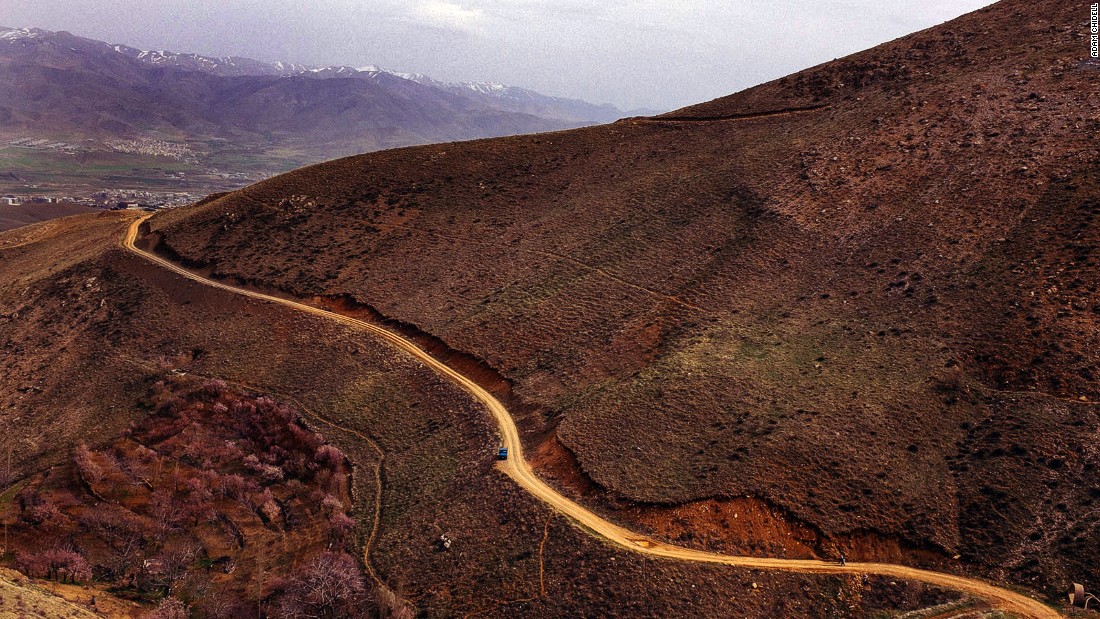The small, gray-haired doctor, leaning across from the passenger seat to tap his friend’s shoulder, imploring him to slow down the black Toyota as we approach another hairpin bend in the dusty road, says “Yavash, yavash ‘slow down’”, Bangkok-based writer and photographer Adam Chidell writes for CNN.
The driver cheerfully ignores the doctor’s pleas and continues to take the corners at a clip, smoking all the while and occasionally breaking into wailed bursts of Kurdish folk song.
We’re traveling from Sanandaj, the capital of Iran’s Kurdistan Province, to Marivan, a small city just a few kilometers from the border with Iraq. It’s the final day of Nowruz, the Iranian new year, and my companions, a doctor called Ghaffar and a taxi driver named Jahan - both from Sanandaj - are still on holiday. In a typical display of Iranian hospitality, they’ve offered to accompany me on the journey.
To the left of the narrow road is a vertical, sand-colored mountain wall. To the right, a 16-meter drop and a view across the spectacular Howraman Valley, also called Uraman, a sparsely populated and beautiful part of the region.
On the eastern edge of Iran, Kurdistan Province makes up part of a broader Kurdish region, which also spans adjacent sections of Iraq, Syria and Turkey.
Over the border in Iraq, the territory has now been targeted by the Islamic militant group known as IS, but Iranian Kurdistan remains unaffected, a peaceful world away from the violence.
Nowruz New Year celebrations are often marked by traditional dances in Iranian Kurdistan. Dress is traditional: men sport baggy trousers, plain shirts and heavy felt waistcoats, while the women wear colorful dresses and headscarves.
On the way, we stop in a tiny village called Negel. The mosque in the village is home to a large, handwritten Qur’an said to be about 1,300 years old.
Uraman-Takht
After Negel, the road winds through snow-capped mountains and then drops down into the village of Uraman-Takht. Here the houses are built into the steep hillside, with the roof of one doubling as a porch area for the building behind. Large blue or green latticed windows face out over the valley. Children chase each other around the streets.
Wandering down the hillside, we stop near a stream to drink tea bought from a small shop. As in other parts of Iran, people don’t sweeten their tea directly, preferring to place a sugar cube between their front teeth and then sucking the tea through the sugar. The teashop owner asks me where I come from: “Russ-stan, French-stan?” he guesses. I tell him “England-stan” and he smiles. “Welcome!”
As we drink the tea, an elderly man walks to the edge of the stream, removes his shoes and socks, rolls up his trousers and wades out to a large, flat rock in the stream. He washes his hands, feet and head and then begins his afternoon prayers, in turn standing, kneeling and then pressing his forehead to the rock. Once he is finished he carefully negotiates the way back and dries his feet with a cloth. As we continue the journey, the doctor takes over the driving and progress is slower, but the hairpin bends are no longer quite so terrifying.
Marivan
We arrive at Marivan in the late afternoon. A large lake catches the afternoon sun and we stop at a restaurant at its edge. Some friends of Dr. Ghaffar join us for a meal of barbecued fish, rice and pickled vegetables. We sit cross-legged on the floor and drink more black tea. Afterward, music is played and people lock arms and dance in a line, men at one end and women at another, jumping in unison and kicking their feet in time to the music. The dancing goes on until the sun sets over the lake.
Sanandaj
We leave Marivan and head back toward Sanandaj. The doctor’s phone rings and he talks in rapid Farsi before suggesting we stop at a friend’s house on the way. “My friend is very wealthy,” he tells me, “and he can trace his family back 1,300 years.”
We stop on the outskirts of Sanandaj. The friend’s house is certainly that of a rich man; thickset gold picture frames enclose black canvases covered in intricate Persian script, thickly woven carpets are laid out across the floor and a huge flat-screen TV sits in the corner, blaring out Kurdish pop music.
I was invited to sit on a sofa. Huge bowls of sweets and cashew nuts are laid out. The man’s eldest daughter takes out her iPhone and shows me photos on her Instagram feed. She plans to go to university in Tehran and wants to study German, and has many questions about life in the West.
Jahan drives back toward the center of Sanandaj. He sings in Kurdish again, but this time there’s a more melancholy tone to the song.
How to Get There
British, Canadian and U.S. citizens wishing to travel to Iran must do so as part of an official tour due to restrictions on independent travel.
Most other foreign nationals need to obtain a visa before traveling and the application process can sometimes seem slightly opaque. It’s worth checking the most up-to-date visa requirements ahead of traveling as these can change with little notice. A variety of airlines fly to Iran, with Tehran’s Imam Khomeini International Airport, the main international hub.
Once in Iran, getting around is made straightforward by the country’s comfortable, extensive and relatively cheap bus or train networks, while for longer distances internal flights are an option.
For shorter journeys and day trips, taxis are relatively affordable due to low fuel costs. In Tehran the metro is a good way to dodge the city’s heavy traffic.


